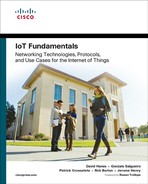Contents
Chapter 2 IoT Network Architecture and Design
Drivers Behind New Network Architectures
Constrained Devices and Networks
The oneM2M IoT Standardized Architecture
The IoT World Forum (IoTWF) Standardized Architecture
Layer 1: Physical Devices and Controllers Layer
IT and OT Responsibilities in the IoT Reference Model
Additional IoT Reference Models
Layer 1: Things: Sensors and Actuators Layer
Layer 2: Communications Network Layer
Gateways and Backhaul Sublayer
IoT Network Management Sublayer
Layer 3: Applications and Analytics Layer
Analytics Versus Control Applications
Data Analytics Versus Business Benefits
IoT Data Management and Compute Stack
The Hierarchy of Edge, Fog, and Cloud
Part II Engineering IoT Networks
Chapter 3 Smart Objects: The “Things” in IoT
Sensors, Actuators, and Smart Objects
Micro-Electro-Mechanical Systems (MEMS)
Wireless Sensor Networks (WSNs)
Communication Protocols for Wireless Sensor Networks
Chapter 4 Connecting Smart Objects
IEEE 802.15.4g and 802.15.4e Conclusions
NB-IoT and Other LTE Variations
NB-IoT and Other LTE Variations Conclusions
Chapter 5 IP as the IoT Network Layer
The Key Advantages of Internet Protocol
Adoption or Adaptation of the Internet Protocol
Mesh-Under Versus Mesh-Over Routing
Authentication and Encryption on Constrained Nodes
Internet Protocol for Smart Objects (IPSO) Alliance
Chapter 6 Application Protocols for IoT
IoT Application Transport Methods
Application Layer Protocol Not Present
Tunneling Legacy SCADA over IP Networks
SCADA Transport over LLNs with MAP-T
IoT Application Layer Protocols
Message Queuing Telemetry Transport (MQTT)
Chapter 7 Data and Analytics for IoT
An Introduction to Data Analytics for IoT
Structured Versus Unstructured Data
Data in Motion Versus Data at Rest
Machine Learning and Getting Intelligence from Big Data
Big Data Analytics Tools and Technology
Massively Parallel Processing Databases
Comparing Big Data and Edge Analytics
Flexible NetFlow in Multiservice IoT Networks
A Brief History of OT Security
Common Challenges in OT Security
Erosion of Network Architecture
Insecure Operational Protocols
DNP3 (Distributed Network Protocol)
ICCP (Inter-Control Center Communications Protocol)
International Electrotechnical Commission (IEC) Protocols
Dependence on External Vendors
How IT and OT Security Practices and Systems Vary
The Purdue Model for Control Hierarchy
OT Network Characteristics Impacting Security
Security Priorities: Integrity, Availability, and Confidentiality
Formal Risk Analysis Structures: OCTAVE and FAIR
The Phased Application of Security in an Operational Environment
Secured Network Infrastructure and Assets
Deploying Dedicated Security Appliances
Higher-Order Policy Convergence and Network Monitoring
An Introduction to Connected Manufacturing
An IoT Strategy for Connected Manufacturing
Business Improvements Driven Through IoT
An Architecture for the Connected Factory
Industrial Automation and Control Systems Reference Model
Resilient Ethernet Protocol (REP)
Business Value of Resiliency in Converged Networks
CPwE Wireless Network Architecture
Real-Time Location System (RTLS)
Industrial Automation Control Protocols
Media Redundancy Protocol (MRP)
A Holistic Approach to Industrial Security
Network Address Translation in the Factory
Factory Security Identity Services
Edge Computing in the Connected Factory
Connected Machines and Edge Computing
An Introduction to the Oil and Gas Industry
Current Trends in the Oil and Gas Industry
Industry Key Challenges as Digitization Drivers
IoT and the Oil and Gas Industry
Improving Operational Efficiency
The Purdue Model for Control Hierarchy in Oil and Gas Networks
IoT Architectures for Oil and Gas
Control Room Networks for Oil and Gas
Wired Networks for Oil and Gas
Wireless Networks for Oil and Gas
Wireless Use Cases in the Oil and Gas Industry
Mobile Process Control Network Operator
The Risk Control Framework for Cybersecurity in IoT
Securing the Oil and Gas PCN: Background
Securing the Oil and Gas PCN: Use Cases and Requirements
Security Intelligence and Anomaly Detection
Data Analytics for Predictive Asset Monitoring
An Introduction to the Power Utility Industry
The GridBlocks Reference Model
GridBlocks: An 11-Tiered Reference Architecture
The Primary Substation GridBlock and Substation Automation
IEC 61850: The Modernization of Substation Communication Standards
Network Resiliency Protocols in the Substation
High-Availability Seamless Redundancy
System Control GridBlock: The Substation WAN
Current Differential (87L) Protection
Designing a WAN for Teleprotection
The Field Area Network (FAN) GridBlock
Advanced Metering Infrastructure
Smart Grid Security Considerations
Chapter 12 Smart and Connected Cities
An IoT Strategy for Smarter Cities
Vertical IoT Needs for Smarter Cities
Smart City Security Architecture
Connected Street Lighting Solution
Smart Traffic Control Architecture
The Need for a Connected Environment
Connected Environment Architecture
Challenges for Transportation Operators and Users
IoT Use Cases for Transportation
Infrastructure and Mass Transit
An IoT Architecture for Transportation
An Introduction to DSRC and WAVE
DSRC/WAVE Protocol and Architecture
Connected Roadways Network Architecture
Extending the Roadways IoT Architecture to Bus Mass Transit
Extending Bus IoT Architecture to Railways
Mining Today and Its Challenges
Challenges for IoT in Modern Mining
Improved Safety and Location Services
An Architecture for IoT in Mining
IEEE 802.11 as the IoT Access Layer
802.11 Wireless Mesh Backhaul Considerations
Antenna Considerations for Wireless Mesh
Wireless in Underground Mining
Isolated vs. Connected Mine Networks
Network Design Consideration for Mining Applications
Public Safety Objects and Exchanges
Public and Private Partnership for Public Safety IoT
Public Safety Adoption of Technology and the IoT
An IoT Blueprint for Public Safety
Emergency Response IoT Architecture
Compute and Applications Services
Mobile Vehicles: Land, Air, and Sea
Compute and Applications Services
IoT Public Safety Information Processing
Bus Location and Student Onboarding/Offboarding
School Bus Safety Network Architecture
